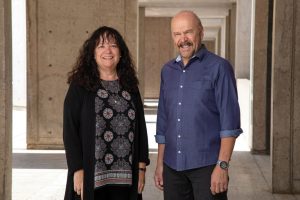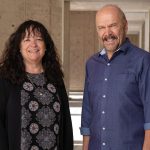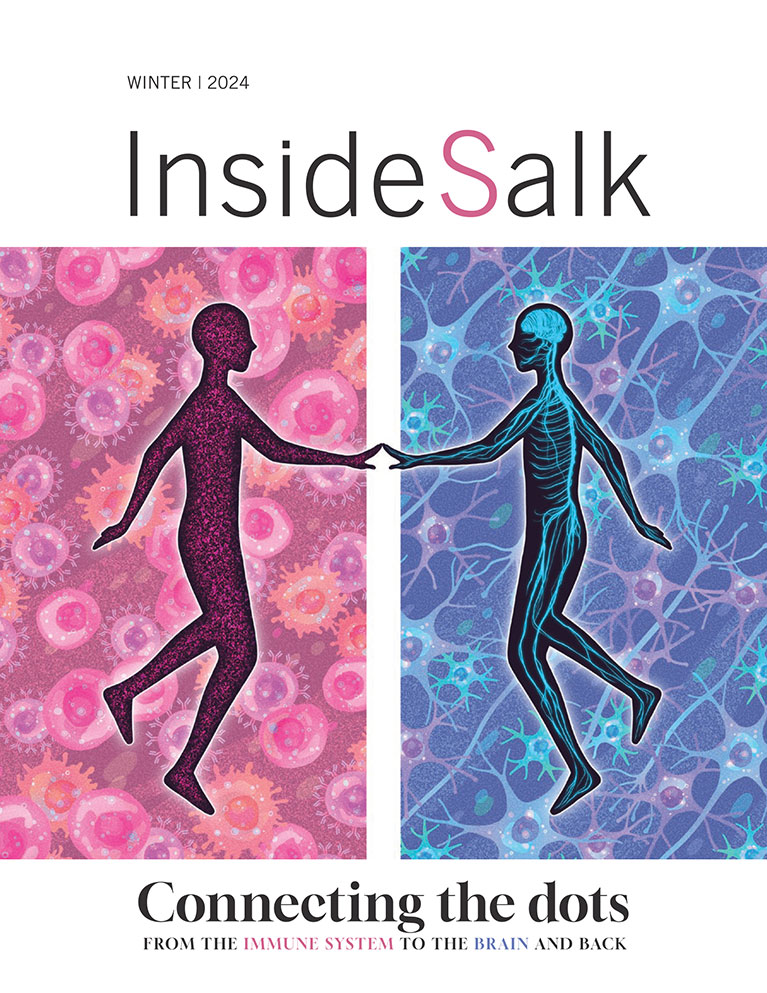In the News Salk scientists lead $126 million effort to map the aging human brain
In the News
The largest grant in Institute history has established the new Center for Multiomic Human Brain Cell Atlas to detail the many individual cells that make up the human brain—their molecular features, where they are found, and how they change with age.
With a five-year, $126 million grant from the National Institutes of Health (NIH), a team led by Salk Institute scientists has launched the new Center for Multiomic Human Brain Cell Atlas. Part of the NIH’s Brain Research Through Advancing Innovative Neurotechnologies (BRAIN) Initiative, the project aims to describe the cells that make up the human brain in unprecedented molecular detail, classify brain cells into more precise subtypes, and pinpoint the location of each cell in the brain. What’s more, the team will track how these features change from early to late life.

From left: Margarita Behrens and Joseph Ecker.
The goal is to better understand how neurotypical human brains work and age. The project will also establish a baseline against which scientists will be able to compare brains with neurological or psychiatric conditions, such as Alzheimer’s disease, autism, depression, and traumatic brain injury.
“The brain map we develop could help point disease researchers in the right direction—for example, we could say, ‘That’s the region of the genome, in that specific subset of neurons, in that part of the brain, where a molecular event goes awry to cause that disease,’” says center leader Professor Joseph Ecker, director of the Genomic Analysis Laboratory at Salk and Howard Hughes Medical Institute investigator. “And ultimately, this information might help us design gene therapies that target only the cell populations where the treatment is needed—delivering the right genes to the right place at the right time.”
In addition to Ecker, the Center for Multiomic Human Brain Cell Atlas includes Research Professor Margarita Behrens and collaborators at UC San Diego, UC Irvine, and Washington University in St. Louis.
Salk will be awarded approximately $77 million of the center’s funding, making it the largest single grant the Institute has received in its 62-year history.
The Center for Multiomic Human Brain Cell Atlas, part of the NIH’s new BRAIN Initiative Cell Atlas Network, builds upon a five-year effort to map the mouse brain, a project that was known as the BRAIN Initiative Cell Census Network. A special issue of Nature published in October 2021 described the results of that effort, including how different cell types are organized and connected throughout the mouse brain.
“Similar to the way we learned about space travel from short trips to the moon, the mouse brain mapping project taught us a lot about how to approach a much bigger brain and the types of genomic information we would need to be able to truly map the human brain,” Behrens says. “This project is an example of how fruitful teamwork can be in science—these types of projects cannot be accomplished in a single lab.”
In the Center for Multiomic Human Brain Cell Atlas, researchers will examine 1,500 brain samples (30 human brains ranging in age, 50 regions each). The center is concerned mostly with epigenetics—the molecular events that influence whether genes are turned “on” or “off” in a given cell type or at a particular time—rather than genetic sequences of each cell. The center will also take into account which cells live where. Location is important because cells talk to each other, Ecker says.
“Essentially, we want to take millions, even hundreds of millions of brain cells, learn everything we can about their epigenetics and how their chromatin is arranged, and project them in a spatial context so we can see where these cells live and understand how all of the cells in any brain region are organized, and at any age,” says Ecker, who also holds the Salk International Council Chair in Genetics.
[ssba]
Support a legacy where cures begin.
Featured Stories
 Human Connection – How social interaction and isolation influence our physical and mental healthSalk neuroscientists study how our brains allow us to experience, interpret, and interact with the world around us. Many of these researchers are now studying not only the brain alone, but the brain in a social context.
Human Connection – How social interaction and isolation influence our physical and mental healthSalk neuroscientists study how our brains allow us to experience, interpret, and interact with the world around us. Many of these researchers are now studying not only the brain alone, but the brain in a social context. Gerald Joyce—An organizing forceJoyce was appointed Salk’s senior vice president and chief science officer in early 2022. Inside Salk sat down with him to learn about his research on the evolution of RNA, as well as the evolution of his career, science, and Salk.
Gerald Joyce—An organizing forceJoyce was appointed Salk’s senior vice president and chief science officer in early 2022. Inside Salk sat down with him to learn about his research on the evolution of RNA, as well as the evolution of his career, science, and Salk.
 Salk scientists lead $126 million effort to map the aging human brainThe largest grant in Institute history has established the new Center for Multiomic Human Brain Cell Atlas to detail the many individual cells that make up the human brain—their molecular features, where they are found, and how they change with age.
Salk scientists lead $126 million effort to map the aging human brainThe largest grant in Institute history has established the new Center for Multiomic Human Brain Cell Atlas to detail the many individual cells that make up the human brain—their molecular features, where they are found, and how they change with age. A life in service to science and others: Walter Eckhart exemplified generosity and kindnessEckhart, professor emeritus and director of the Salk Institute’s National Cancer Institute-designated Cancer Center and head of the Molecular and Cell Biology Laboratory for more than 30 years, died on June 21, 2022, at his home in La Jolla, California, at the age of 84.
A life in service to science and others: Walter Eckhart exemplified generosity and kindnessEckhart, professor emeritus and director of the Salk Institute’s National Cancer Institute-designated Cancer Center and head of the Molecular and Cell Biology Laboratory for more than 30 years, died on June 21, 2022, at his home in La Jolla, California, at the age of 84.  Georg Heinrich “Heini” Thyssen-Bornemisza—Salk Institute mourns loss of influential former Board memberThyssen’s leadership and generosity helped accelerate scientific efforts at the Institute over the years, always with a focus on allowing Salk scientists to continue their pursuit of high-risk, high-impact research. He died on September 30, 2022.
Georg Heinrich “Heini” Thyssen-Bornemisza—Salk Institute mourns loss of influential former Board memberThyssen’s leadership and generosity helped accelerate scientific efforts at the Institute over the years, always with a focus on allowing Salk scientists to continue their pursuit of high-risk, high-impact research. He died on September 30, 2022. Mallory Zaslav—Valuing the differences in backgrounds and experiencesAs vice president of Diversity, Equity & Inclusion, Zaslav’s forward thinking and advocacy have given shape to a range of impact-driven programming and outreach, furthering Salk’s mission of bettering humanity by pushing the boundaries of innovation and discovery.
Mallory Zaslav—Valuing the differences in backgrounds and experiencesAs vice president of Diversity, Equity & Inclusion, Zaslav’s forward thinking and advocacy have given shape to a range of impact-driven programming and outreach, furthering Salk’s mission of bettering humanity by pushing the boundaries of innovation and discovery. Katia Troha—Discovering diets that boost survival during infectionGrowing up in Peru, Troha’s love of science was fueled by documentaries on groundbreaking studies like the first cloned mammal, Dolly the sheep. She is now a postdoctoral researcher in the Salk lab of Professor Janelle Ayres.
Katia Troha—Discovering diets that boost survival during infectionGrowing up in Peru, Troha’s love of science was fueled by documentaries on groundbreaking studies like the first cloned mammal, Dolly the sheep. She is now a postdoctoral researcher in the Salk lab of Professor Janelle Ayres. Heithoff-Brody High School Summer Scholars program paves the way for future scientistsFor more than 30 years, Salk’s Heithoff-Brody High School Summer Scholars program has provided hands-on laboratory experiences for local high school students interested in exploring careers in science, technology, engineering, and math.
Heithoff-Brody High School Summer Scholars program paves the way for future scientistsFor more than 30 years, Salk’s Heithoff-Brody High School Summer Scholars program has provided hands-on laboratory experiences for local high school students interested in exploring careers in science, technology, engineering, and math.



















































